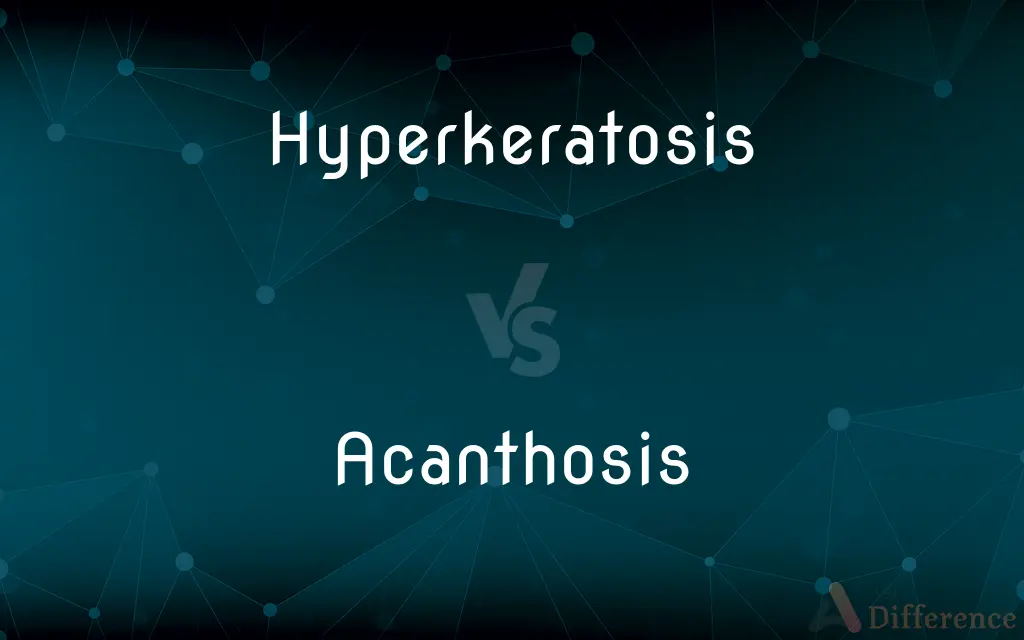Hyperkeratosis vs. Acanthosis — What's the Difference?
Edited by Tayyaba Rehman — By Maham Liaqat — Updated on February 27, 2024
Hyperkeratosis is the thickening of the skin's outer layer due to excessive growth of keratinocytes, while acanthosis refers to the thickening of the skin's spinous layer, often associated with darkened patches, particularly in skin folds.

Difference Between Hyperkeratosis and Acanthosis
Table of Contents
ADVERTISEMENT
Key Differences
Hyperkeratosis and acanthosis are both conditions involving the abnormal thickening of the skin, but they affect different layers and have distinct causes and appearances. Acanthosis, specifically acanthosis nigricans, involves the thickening and darkening of the skin, particularly in body folds such as the armpits, groin, and neck. This condition is often associated with insulin resistance and can be a marker for diabetes and obesity.
Hyperkeratosis primarily results from an overproduction of keratin, a protective protein found in the skin, hair, and nails, leading to a thickened stratum corneum (the skin's outermost layer). Hyperkeratosis is characterized by rough, often dry patches or growths that can vary in color but are typically not associated with darkening of the skin. Unlike hyperkeratosis, the primary feature of acanthosis is the velvety, darkly pigmented areas of skin that may appear gradually.
Hyperkeratosis can manifest as calluses or corns on the hands and feet, actinic keratosis due to sun exposure, or as part of other skin disorders. Acanthosis can also be linked to hormonal disorders, certain medications, and, less commonly, cancer.
The key differences between these conditions lie in their underlying causes, affected skin layers, and clinical presentations. Hyperkeratosis focuses on the buildup of keratin leading to skin thickening without necessarily causing darkening, while acanthosis is characterized by both thickening and notable darkening of the skin. Treatment and management strategies for these conditions will vary, emphasizing the importance of understanding their distinct natures for proper diagnosis and care.
Comparison Chart
Definition
Thickening of the outer layer of the skin due to excessive keratin production.
Thickening of the skin's spinous layer, often with skin darkening.
ADVERTISEMENT
Affected Layer
Stratum corneum (outermost layer).
Spinous layer (beneath the stratum corneum).
Common Causes
Friction, UV exposure, genetic disorders.
Insulin resistance, obesity, hormonal disorders.
Symptoms
Rough, dry patches; calluses; corns.
Velvety, dark patches of skin, especially in folds.
Associated Conditions
Actinic keratosis, psoriasis, and eczema.
Diabetes, obesity, and, rarely, cancer.
Treatment
Topical treatments, removal of the cause (e.g., reducing friction), sun protection.
Addressing underlying conditions (e.g., improving insulin sensitivity), topical treatments.
Compare with Definitions
Hyperkeratosis
Can lead to dry, scaly skin patches.
Regular use of moisturizers can help manage hyperkeratosis symptoms.
Acanthosis
Indicates underlying health issues.
The presence of acanthosis nigricans can signal insulin resistance.
Hyperkeratosis
Excess skin thickening from keratin buildup.
Calluses on a guitarist's fingers are a form of hyperkeratosis.
Acanthosis
Skin thickening with darkened patches.
Acanthosis nigricans often appears as dark patches in the armpits.
Hyperkeratosis
Often caused by repeated friction or pressure.
Wearing tight shoes can result in hyperkeratosis on the feet.
Acanthosis
Develops mainly in skin folds.
Dark, velvety patches in the neck fold are common signs of acanthosis.
Hyperkeratosis
Treated by removing the cause and skincare.
Keratolytic agents are used to treat hyperkeratosis by softening and peeling the thickened skin.
Acanthosis
Can be associated with obesity or diabetes.
Weight loss can significantly improve the appearance of acanthosis nigricans.
Hyperkeratosis
May be part of a skin disorder's symptoms.
Psoriasis can cause hyperkeratosis, leading to thick, scaly skin patches.
Acanthosis
Managed by treating the root cause.
Improving diet and exercise routines can help reduce the signs of acanthosis related to obesity.
Hyperkeratosis
Hyperkeratosis is thickening of the stratum corneum (the outermost layer of the epidermis, or skin), often associated with the presence of an abnormal quantity of keratin, and also usually accompanied by an increase in the granular layer. As the corneum layer normally varies greatly in thickness in different sites, some experience is needed to assess minor degrees of hyperkeratosis.
Common Curiosities
Can hyperkeratosis be prevented?
Minimizing skin trauma and protecting the skin from excessive UV exposure can reduce the risk of some forms of hyperkeratosis.
Is acanthosis nigricans reversible?
Yes, with appropriate treatment of the underlying condition, such as improving insulin sensitivity, the appearance of acanthosis nigricans can improve.
Can lifestyle changes help manage these conditions?
Yes, particularly for acanthosis nigricans associated with obesity and insulin resistance, lifestyle changes can be beneficial.
Is acanthosis nigricans always a sign of diabetes?
While often associated with insulin resistance and diabetes, acanthosis nigricans can also result from other conditions or genetic factors.
Should people with these conditions see a dermatologist?
Yes, consulting a dermatologist is advisable for accurate diagnosis, treatment options, and management of both hyperkeratosis and acanthosis nigricans.
Can these conditions affect all age groups?
Yes, both hyperkeratosis and acanthosis nigricans can occur in children and adults, though the prevalence and causes may vary with age.
Can hyperkeratosis lead to cancer?
Certain types, like actinic keratosis, can potentially progress to skin cancer if left untreated.
How are hyperkeratosis and acanthosis diagnosed?
Diagnosis typically involves a physical examination, review of medical history, and sometimes skin biopsies to examine the affected tissues.
Are there home remedies for these conditions?
While home care can help manage symptoms, professional medical advice is essential for proper treatment, especially to address the underlying causes.
How common are hyperkeratosis and acanthosis?
Hyperkeratosis is quite common and occurs in various forms, while acanthosis nigricans is less common and often linked to specific health issues.
Share Your Discovery

Previous Comparison
Turn vs. Alter
Next Comparison
Blunder vs. MistakeAuthor Spotlight
Written by
Maham LiaqatEdited by
Tayyaba RehmanTayyaba Rehman is a distinguished writer, currently serving as a primary contributor to askdifference.com. As a researcher in semantics and etymology, Tayyaba's passion for the complexity of languages and their distinctions has found a perfect home on the platform. Tayyaba delves into the intricacies of language, distinguishing between commonly confused words and phrases, thereby providing clarity for readers worldwide.














































